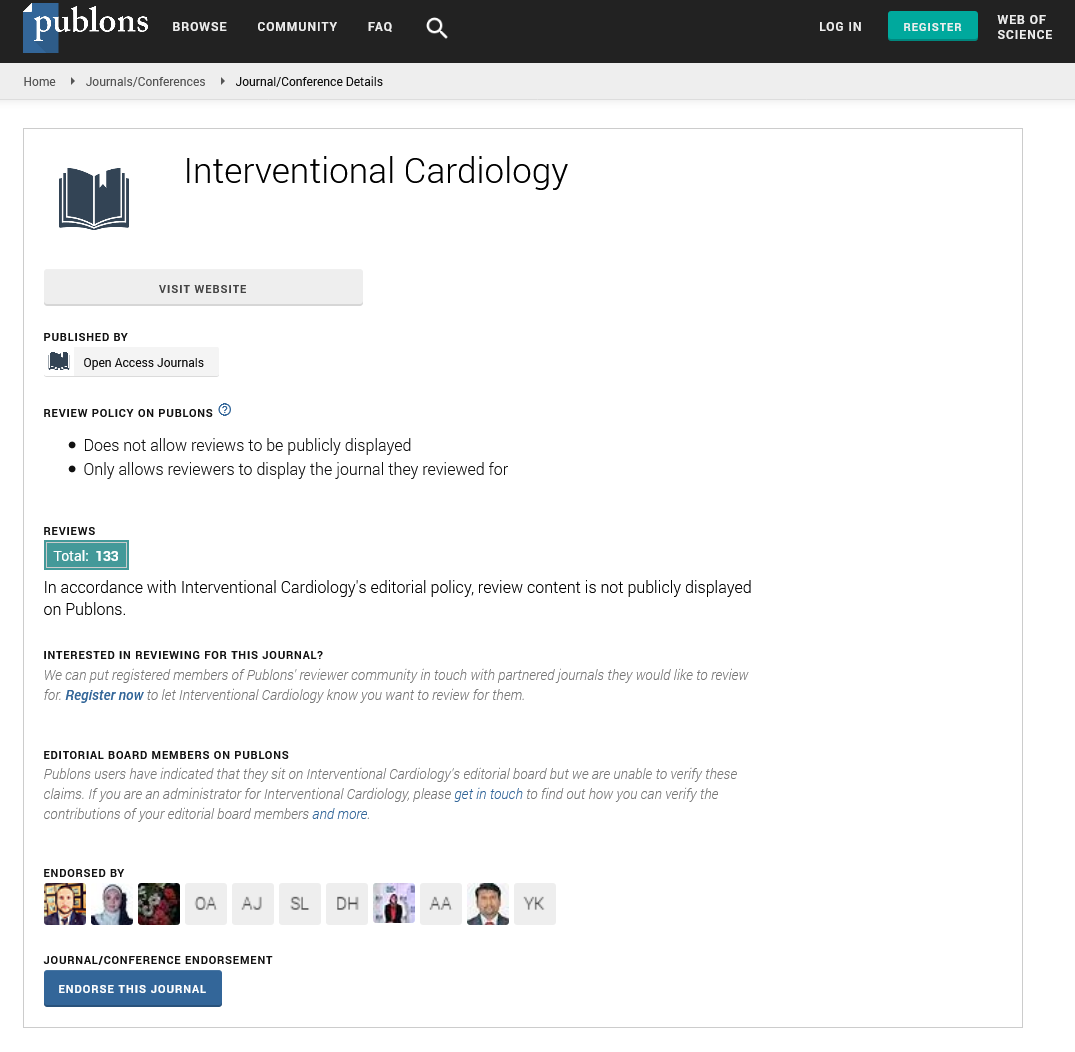Short Communication - Interventional Cardiology (2025) Volume 17, Issue 0
Bridging the Gap: On Improving Hemodialysis Access for Undocumented Patients with End-Stage Renal Disease
- Corresponding Author:
- Cynthia A. Ramazani
Emory University School of Medicine, Atlanta, Georgia
E-mail: cynthiaramazaniamani@gmail.com
Received date: 03-Feb-2025, Manuscript No. FMIC-25-164879; Editor assigned: 05-Feb-2025, PreQC No. FMIC-25-164879 (PQ); Reviewed date: 19-Feb-2025, QC No. FMIC-25-164879; Revised date: 26-Feb-2025, Manuscript No. FMIC-25-164879 (R); Published date: 05-Mar-2025, DOI: 10.37532/1755- 5310.2025.17(S27).703
Description
The path to Hemodialysis (HD) is one of the most intricate and time-sensitive transitions in chronic disease management. For undocumented immigrants in the United States with End-Stage Renal Disease (ESRD), this journey is made even more difficult by a unique set of systemic and policy-level barriers. Due to limited eligibility for federal programs such as Medicare, the Affordable Care Act, and most state Medicaid programs, most undocumented patients do not qualify for standard outpatient dialysis [1]. In many states, dialysis is only available when patients present critically ill to the emergency department (emergency-only dialysis), which happens on average 6 times per month [2,3].
In our recent single-center study, we examined how these structural limitations impact access to timely dialysis-related specialty care among undocumented patients initiating HD. Compared to their documented peers, undocumented patients were significantly more likely to receive delayed nephrology and vascular access surgery evaluations, often after starting HD. Nearly 60% of undocumented patients saw a nephrologist for the first time on the day they started dialysis. More than 74% were not evaluated for vascular access surgery until after HD had already begun. Consequently, 90.3% of undocumented patients started dialysis with a Central Venous Catheter (CVC), compared to 66.7% of documented patients (P<.001). Importantly, once undocumented patients were evaluated by vascular surgery, they experienced no significant delay in AV access creation or maturation compared to their documented counterparts [4].
This suggests that the primary barrier lies in delayed opportunity for evaluation by vascular access surgery, rather than in surgical scheduling or procedural follow-up. A number of factors likely contribute to these delays, including lack of insurance, difficulty navigating the healthcare system, and language barriers [5]. Without early nephrology or primary care involvement, opportunities to coordinate timely vascular access placement are missed. This increases the likelihood of starting dialysis with a catheter, which carries well-documented risks [6-8].
While CVCs are necessary in acute situations, long-term dependence on catheters for HD is associated with higher risks of infection, mechanical malfunction, and central venous stenosis. In our study, undocumented patients who remained catheter-dependent experienced significantly more catheter-associated complications than those who eventually transitioned to Arteriovenous (AV) access (72.5% vs 45.9%; P=.032) [4]. These findings align with prior literature showing increased morbidity and mortality with prolonged catheter use compared to AV fistulas or grafts [9].
From an economic perspective, the emergency-only dialysis model imposes a substantial burden on the healthcare system. Estimates suggest that emergency dialysis can cost between $285,000 and $400,000 per patient annually, while outpatient HD typically ranges from $76,000 to $91,000 [10,11]. Catheter-related infections alone can cost $17,000 to $32,000 per episode, further amplifying the financial burden of delayed care [12].
While transitioning to AV access improves outcomes, our data showed that undocumented patients who eventually transitioned from a CVC to AV access were more likely to experience an earlier onset of catheter-related complications compared to their undocumented peers who remained CVC-dependent. This finding highlights a broader issue in how care is often delivered: A reactive rather than proactive approach. Because undocumented patients may not be evaluated early or their need for timely specialty care is not prioritized, they frequently remain with suboptimal access until a complication prompts hospitalization. In many cases, the opportunity to plan for durable vascular access arises only after a preventable complication has already occurred. This cycle underscores the need for a more proactive model, one that emphasizes early identification, timely referrals, and coordinated care. Such an approach could not only reduce the risk of complications but also support a safer and more sustainable transition into chronic dialysis.
Some states have begun to address this emergency dialysis issue by expanding Emergency Medicaid to include outpatient dialysis for undocumented patients [13]. As of 2023, 17 states have adopted this model. Although broader policy reform is a long-term process, this development offers a promising path toward more sustainable and equitable care delivery. Comparative studies between regions with and without expanded coverage could provide valuable insights into long-term impacts.
In the meantime, institutions can adopt strategies to improve care coordination and reduce delays. At our institution, a dialysis care coordinator has recently been introduced to support patients in navigating referrals, scheduling, financial clearance, and language barriers - common obstacles that delay timely access to dialysis-related care. This role was introduced to help address known barriers to timely nephrology and vascular surgery evaluations. While the impact of this initiative is still being assessed, we anticipate that this intervention will improve care navigation, facilitate earlier AV access placement, and ultimately help reduce catheter dependence by supporting safer, more timely transitions to adequate long-term dialysis AV access.
Conclusion
In summary, our study highlights that undocumented patients with ESRD are more likely to experience delays in specialty care and start dialysis with a catheter, which increases their risk
of complications. Addressing this issue requires a multifaceted
approach, including improved early referral systems, institutional support through patient care coordination, and, where possible,
expanded policy coverage for outpatient dialysis. These steps may
contribute to better patient outcomes, reduced complications, and
more efficient use of healthcare resources.
References
- Rizzolo K, Dubey M, Feldman KE, et al. Access to kidney care for undocumented immigrants across the United States. Ann Intern Med. 176(6):877-879 (2023).
- Rizzolo K, Novick TK, Cervantes L, et al. Dialysis care for undocumented immigrants with kidney failure in the COVID-19 era: Public health implications and policy recommendations. Am J Kidney Dis. 76(2):255 (2020).
- Gray NA. Cruel Carousel: The Grim Grind of" Compassionate" Dialysis. AMA J Ethics. 20(8):E778-E779 (2018).
- Ramazani CA, Rooney E, Bombly K, et al. Challenges surrounding hemodialysis initiation faced by undocumented immigrants. J Vasc Surg. (2025).
- Iorember FM, Bamgbola OF. Structural inequities and barriers to accessing kidney healthcare services in the United States: A focus on uninsured and undocumented children and young adults. Front Pediatr. 10:833611 (2022).
- Poinen K, Quinn RR, Clarke A, et al. Complications from tunneled hemodialysis catheters: A Canadian observational cohort study. Am J Kidney Dis. 73(4):467-475 (2019).
- Santoro D, Benedetto F, Mondello P, et al. Vascular access for hemodialysis: Current perspectives. Int J Nephrol Renovasc Dis. 8:281-294 (2014).
- Sohail MA, Vachharajani TJ, Anvari E. Central venous catheters for hemodialysis-the myth and the evidence. Kidney Int Rep. 6(12):2958-2968 (2021).
- Ravani P, Palmer SC, Oliver MJ, et al. Associations between hemodialysis access type and clinical outcomes: A systematic review. J Am Soc Nephrol. 465-473 (2013).
- Nguyen OK, Vazquez MA, Charles L, et al. Association of scheduled vs emergency-only dialysis with health outcomes and costs in undocumented immigrants with end-stage renal disease. JAMA Intern Med. 179(2):175-183 (2019).
- Douthit NT, Old C. Renal replacement therapy for undocumented immigrants: Current models with medical, financial, and physician perspectives-a narrative review. J Gen Intern Med. 34:2246-2253 (2019).
- Kosa SD, Lok CE. The Economics of hemodialysis catheter-related infection prophylaxis. Semin Dial. 26(4):482-493 (2013).
- Park JK, Reyes-Becerra C, Makhlouf MD, et al. State flexibility in emergency medicaid to care for uninsured noncitizens. JAMA Health Forum.

